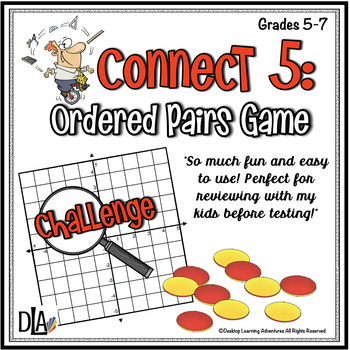Ordered Pairs Coordinate Plane Game - 1st Quadrant & 4 Quadrant Boards
Also included in
- This engaging ordered pairs bundle brings the best of the coordinate plane, ordered pairs, and polygons together in one easy-to-use bundle. Whether you're looking for math stations, sub day activities, homework practice or Plan B, this bundle will meet your needs!© Pamela Kranz Desktop Learning AdvePrice $9.75Original Price $12.25Save $2.50
Description
This easily-differentiated math game gives students practice using the coordinate plane, as they decide where to place their ordered pairs to their best advantage. Who says math practice can’t be fun?!
Ways to use Connect 5: Ordered Pairs Game
Practice • Centers • Go-to Activities • Fun Class Challenge • Test Prep • Sub Day
In addition to several ideas for differentiation, this set includes:
♦ 12 full-sized & 24 half-sized colored game boards
♦ 2 large and 2 small BW boards versions
♦ Pairing cards to match colored game boards
♦ 81 BW ordered pair cards
♦ Wild Cards & Challenge Cards
♦ 4 1st-Quadrant boards (2 BW)
♦ 81 BW 1st Quadrant ordered pair cards
Looking for more practice games and activities?
Click HERE for Protractor Practice- Crack the Code Activities Bundled!
Click HERE for Crack the Code math practice puzzles.
***************************************************************************
Customer Tips:
How to get TpT credit to use on future purchases:
Please go to your My Purchases page (you may need to login). Beside each purchase you’ll see a Provide Feedback button. Simply click it and you will be taken to a page where you can give a quick rating and leave a short comment for the product. Each time you give feedback, TpT gives you feedback credits that you use to lower the cost of your future purchases. I value your feedback greatly, as it helps me determine which products are most valuable for your classroom, so I can create more for you.
Be the first to know about my new discounts, freebies and product launches:
Look for the green star next to my store logo and click it to become a follower. Voila! You will now receive email updates about this store!
Thanks for stopping by! Pam Kranz
***************************************************************************
© Pamela Kranz Desktop Learning Adventures All Rights Reserved






